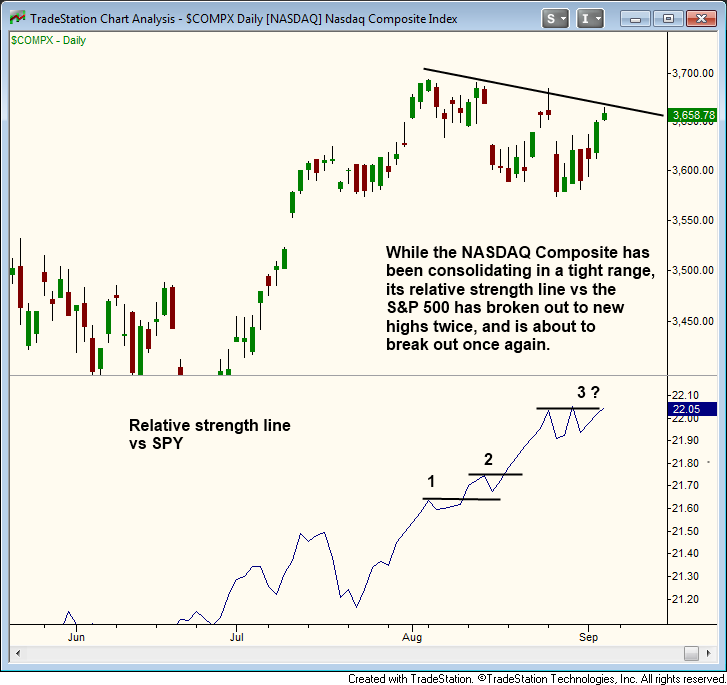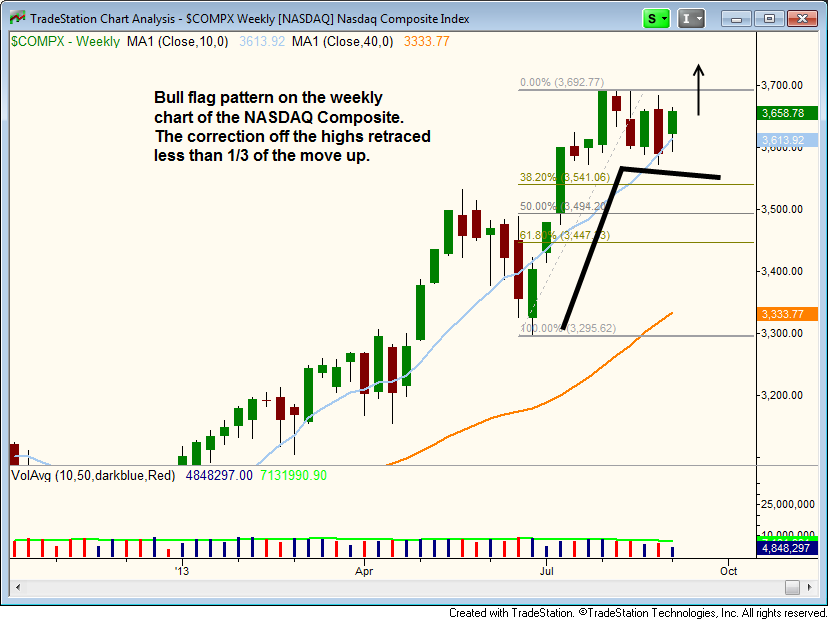| The Wagner Daily ETF Report For September 6 |
| By Deron Wagner |
Published
09/6/2013
|
Stocks
|
Unrated
|
|
|
|
The Wagner Daily ETF Report For September 6
For the past six weeks, the NASDAQ Composite Index ($COMP) has been uneventfully oscillating in a sideways trading range (a 3% range from the upper channel resistance down to lower channel support).
However, we have identified three highly reliable technical indicators that point to a strong likelihood of the NASDAQ soon breaking out to a fresh, multi-year high (despite continued weakness in the S&P 500 and Dow Jones).
1.) The Most Reliable Indicator You Probably Never Use
We prefer to keep our technical analysis of stocks pretty simple. Although there are literally hundreds of technical indicators at our disposal, we rely primarily on price, volume, support/resistance levels (such as trendlines and moving averages), and the relative strength line.
The relative strength line is a simple leading indicator that allows us to easily see how a stock or ETF is performing against the benchmark S&P 500 Index ($SPX). This is not to be confused with the RSI indicator (relative strength index).
When the relative strength line is outperforming the price action of the stock (or the Nasdaq Composite in this case), it is a reliable bullish signal that often precedes further gains in price.
On the chart below, notice how the relative strength line has already broken out to new highs twice, even though the NASDAQ has been trending sideways to slightly lower. This is a clear sign that institutional funds have been rotating out of the S&P 500 and into the NASDAQ:

2.) We Are Quite Loyal To This Flag
While the relative strength line is one of the most reliable technical indicators to predict future price action, the bull flag is definitely one of our favorite bullish chart patterns to identify and profit from.
On the longer-term weekly chart, we clearly see the Nasdaq has been forming a bull flag chart pattern. This is annotated by the black lines we have drawn on the chart below:

Notice that the rally off the lows in July created the flag pole part of the bull flag pattern, while the current sideways price action forms the flag.
The tight consolidation of the past six weeks has retraced less than one-third of the last wave up. This is what we like to see, as the best-formed bull flag patterns should not pull back to more than a 38.2% Fibonacci retracement of last move up.
Finally, since the flag pole and the flag are frequently symmetrical in time, we need to compare how long it took for the pole to form with the length of the flag.
Since the pole was created over the span of six weeks, the anticipated breakout from the bull flag pattern should occur after the flag has formed for 5-7 weeks (we are currently on week 5).
3.) Already Leading The Market Higher
When I began trading and studying technical analysis many years ago, I assumed that the main stock market indexes (such as the NASDAQ) led the way for the top-performing stocks to move higher.
I was definitely wrong.
The reality is the opposite situation; leading individual stocks set the pace for the broad market to follow.
When the strongest stocks in the market (typically small to mid-cap growth stocks) are convincingly breaking out to new highs ahead of the broad-based indexes, it is a very bullish sign and the main stock market indexes usually follow suit.
Conversely, it is a bearish signal when the major indices are trending higher, but without clear leadership among individual stocks.
Right now, there is a plethora of stocks that are breaking out to new highs ahead of the NASDAQ.
In no particular order, here are the ticker symbols of a handful of stocks breaking out right now, or have already broken out, to new highs: $QIHU, $LNKD, $TSLA, $NFLX, $KORS, $LOCK, and $YELP.
We are presently long four of the above stocks in our Wagner Daily newsletter, and with the following unrealized gains since our original buy entries (based on Sept. 5 closing prices): YELP +16.3%, LOCK +9.1%, LNKD +7.9%, and KORS +7.3%.
In case you missed it, you may want to check out our original August 21 analysis of Yelp ($YELP) (before it broke out and zoomed higher over the past few days).
You may also be interested in our educational August 26 video analysis of Amazon ($AMZN). In that video, we suggested $AMZN was setting up for a pullback buy entry and would start rallying again after pulling back to the $280 area (it's back up to $294 now).
Death And Taxes - The Only Sure Things
As my grandmother loved to tell me, "the only sure things in life are death and taxes." I agree, especially when it comes to the stock market.
Obviously, the Nasdaq has not yet broken out, and there is no guarantee that it will.
Nevertheless, the combination of the three reliable technical indicators above suggest a strong likelihood that the tech-heavy index will soon break out of its range and cruise to a new, multi-year high (though the S&P and Dow are another story).
If the Nasdaq suddenly rallies to new highs as anticipated, are you prepared to take advantage of the move? Do you know which stocks will offer the best odds for high profits?
Deron Wagner is the Founder and Head Trader of both Morpheus Capital LP, a U.S. hedge fund, and MorpheusTrading.com, a trader education firm.
|